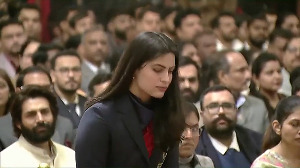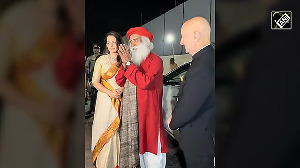'Fan armies are not just followers; they are a force of nature.'

Sukumar's Pushpa 2: The Rule, the sequel to the 2021 hit Pushpa: The Rise, is one of the most awaited movies of 2024 and is due for release on December 6.
Earlier this year, Mythri Movie Makers released a teaser that was viewed over 100 million times on YouTube as was the title music video on T-Series' channels on the same platform. Fans also started creating reaction videos, trailer breakdowns, memes, dance trends and even VFX (visual effects) edits, literally embedding themselves into the movie frames.
"Fan armies are not just followers; they are a force of nature. They are not just consuming content but creating it; fan culture is now a driver of popular culture," says Ishan John Chatterjee, managing director, YouTube India.
As the boundaries between creators and fans dissolve online, fan armies are key to amplifying, creating and even monetising content. That essentially is the crux of a small discussion the world's (and India's) largest streaming app had recently, before the tenth YouTube Fanfest began.
The Fanfest, which had over 5,000 people in attendance last year, is now part of the popular culture ecosystem that YouTube creators such as Shivani Kapila (Little Glove, 16 million subscribers) or Mahesh Keshwala (Thugesh, 5.78 million subscribers) dominate.
To mark it, YouTube also released a Culture and Trends report in partnership with research firm SmithGeiger showcasing the evolution of fandom.

However, it is important to contextualise the report first. In June 2024, YouTube had 462 million unique visitors, according to Comscore data. That is over 88 per cent of all people using the internet for news, entertainment or information.
While the report is based on small sample sizes (between 300 to 400 per question), if one projects it onto YouTube's reach, the implications are larger.
Going by the research, in India, 91 per cent of Gen Z fans (online 14 to 24 year olds who identify as fans) have engaged in fan-related activities in the past 12 months. YouTube India declines to share what proportion of its reach is Gen Z but "it is core to our audience," says Chatterjee.
The ability to make short videos easily and generative AI (artificial intelligence) have given fans more and increasingly creative ways to participate in their fandoms. That participation, with its varying degrees of commitment and engagement, has led to a stratification of sorts, says the research.
Casual fans may just consume media, but super fans routinely create media about the object of their fandom, and often spend money on it. In short, the bigger the fan, the more content they are likely to consume and create.

More than 80 per cent of them are alright with brands being engaged with people or channels they are fans of. And a similar number identify themselves as creators. More than two-third of Gen Z admit to being fans of a person or niche that no one they know is part of.
Chatterjee points out to the little islands of content that popular creators, say UPSC teachers like Vikas Divyakirti (3.75 million subscribers) and Vijender Maseejeevi (522,000 subscribers) and their fans create. There is a whole creator and fan ecosystem around railways, railway carriages and trains.
"We are not just witnessing the rise of fandom but helping fuel it by simplifying creation and helping unlock monetisation through special chats or engagement with super fans," says Chatterjee.
How does YouTube deal with the toxicity that is very real on other platforms?
"YouTube is the only platform where I haven't faced any hate or toxic comments," says Kapila.
She blogs about life in a joint family. Keshwala, who does a popular online talk show, and Naman Mathur, who does live streaming gaming videos under the name MortaL (7 million subscribers), agree.
Chatterjee says that YouTube invests a lot in technology to ensure that toxicity remains off the platform. The next step is to build an AI-powered dubbing tool that can help creators go global.
According to estimates, YouTube India had gross ad revenues of Rs 14,000 crore (Rs 140 billion) in the financial year 2023. Roughly half of that goes to creators. It is certainly a constituency to keep investing in.













 © 2025
© 2025